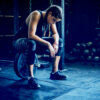Self-selecting the weight on an exercise is something that almost everyone has to do at some point. Trainees are often asked to self-select weights that will allow them to hit a predetermined target of reps or even a predetermined repetitions-in-reserve before they hit muscular failure. Do we lift heavy enough when asked to self-select weights and if not, how can we make sure that we do?
Overview
What did they test? The authors reviewed the current available literature to examine what loads (aka weight) people select when asked to "self-select" loads.
What did they find? On average, people self-selected loads corresponding to approximately 53%1RM, which would be classified as light to moderate.
What does it mean for you? When self-selecting loads, it is important to ensure that your sets are 0-3 repetitions away from failure, regardless of load selected. Additionally, self-selecting loads with a predetermined proximity to failure and rep range may make training more efficient and less discomforting, especially if sets of 12+ repetitions are not your “cup of tea”.
What’s the Problem?
When lifting weights one of the important decisions that one needs to make is… wait for it… select the weight they will lift. How much we lift can be an important factor in determining what we get out of our workouts. That said, we know that you can get bigger and stronger with lighter weights performed for higher repetitions 1 and vice versa, as the traditionally thought “strength and endurance continuum” is not as absolute as it was once presented to be. Although optimal for one-repeition-maximum strength (1RM), lower reps (<5) at heavier loads, can lead to significant increases in hypertrophy as can very high reps (>15) at light loads 1. Increases in 1RM strength seem to be better attained by lifting heavier loads for lower reps (<5) but that’s probably due to the resemblance of the training to the test used to assess strength. Regardless, although heavier loads being better for 1RM strength, moderate to light loads (40-80%1RM) can also lead to significant increases in strength.
The American College of Sports medicine currently recommends that people should lift around 60-80% of their 1RM during training when looking at improving strength and hypertrophy. Those recommendations make some intuitive sense given that they will allow you to efficiently get close to failure without having to perform a bunch of reps while also being heavy enough to give you some 1RM “specific” practice (although probably suboptimal). Training 0-3 repetitions shy off momentary failure, ie: the point where you cannot complete another concentric repetitions despite attempting to do so, is important when looking to get the most out of your sets in terms of muscle growth 2. Despite the above recommendations being fine, they require the following a one repetition maximum test to be performed on the exercise you’re training on (or at least the estimation of a 1RM) something that can be somewhat time consuming and will also need to be done periodically to ensure that you’re keeping the percentages up to date. This can be somewhat of a challenge for less experienced trainees as their 1RM strength on any given exercise may be changing rather quickly mostly due to the neurological adaptations of getting used to lifting. Having to frequently test your 1RM can also be somewhat of a challenge if you’re performing a bunch of exercises, especially exercises where you wouldn’t normally test your 1RM on (eg: overhead tricep extensions or split squats).
For that reason, we, coaches & practitioners, often instruct trainees to self-select loads they feel are appropriate for a particular repetition and repetitions-in-reserve range. That could be something like “select a load that is heavy enough for you to do 8-10 reps on the bench press while leaving 1 to 3 repetitions in the tank before reaching failure”. Aside from the flexibility that such an approach provides, it also allows for any performance fluctuations to be accounted for on a daily basis, as your strength will not always be the same on any particular day. Previous research has looked at whether individuals can accurately predict how close they are to failure and has found that both trained and untrained individuals overestimated their proximity to failure by almost one repetition 3, so not too shabby at all.








